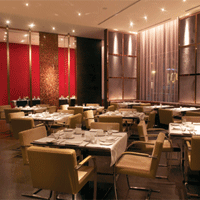The hotel F&B program evolves with its gastronomy-savvy clientele
President Barack Obama has been talking about it for what seems like forever, but change is more than an election promise, it’s a certainty that remains rooted in our past, present and future economic climate. The story is no different in hotel foodservice, which has and continues to undergo a renaissance.
What used to be an overpriced, mediocre no-name dining room in the bowels of a hotel has been transformed into a cutting-edge, tourist destination that, in more and more cases, is the heart of the property. “We probably bring the hotel more business than the hotel brings us,” admits Tiffany Smith-Diggins, manager of One Restaurant, celebrity chef Mark McEwan’s hotspot at Yorkville’s tony Hazelton Hotel in Toronto.
“We’ve done things before, where people were very upset that we couldn’t fit them in the dining room, so we’ve given them a suite for the evening and served them a full dinner in a suite with a server.”
Attracting city dwellers and hotel guests to nosh at the local hostelry is one thing but affordability is another growing commonality in the segment. That’s the plan at world renowned chef Jean-Georges Vongerichten’s restaurant, Market, which opened inside the new Shangri-La hotel in Vancouver earlier this year. “Serving a quality product at an accessible price is one of the biggest changes in hotel dining, whereas before hotel restaurants used to be where guests went for a birthday, anniversary or Christmas dinner. [Hotel restaurants] need to offer more every day to compete for those standalone restaurant dollars,” explains the hotel and restaurant’s executive chef, David Foot, alluding to Vongerichten’s insistence that Market offer a prix-fixe lunch with an app, main and dessert for $28 [Think: cucumber yogurt soup, parmesan crusted organic chicken and chocolate pudding]. “It’s the best deal in town.”
Shaking up the menu and luring in locals has been the modus operandi for hotel foodservice across the board. “My lunch service is more dependant on my outside guests than it is on my guests staying in house,” admits James Piggott, executive chef at The Westin Prince, Toronto, where he oversees banquets, room service and the restaurant outlets Seasons at The Prince and Bar 900. “It’s about your capture period. Breakfast, to a great extent, attracts hotel guests. But at lunch and dinner we can get a ton of just-off-the-street walk-ins, which is great — it’s what we’re looking for.”
That’s true now more than ever as hotel operators fight to fill their banquet halls and restaurants while working to regain footing after a tumultuous year. Market and One may not have slowed down during the recession, but many other hotel foodservice outlets haven’t been as lucky. “This has been a very, very unique year in terms of what is going to happen next,” explains Robert Hood, corporate food & beverage manager at Atlific Hotels, which owns and/or manages more than 40 properties throughout the country, including the new Westin Montreal. “In our business, we’re kind of watching our competition, keeping our eye on trends and just feeling it out. The first quarter of the year for us was extremely strong.” Offering value to hotel guests and city residents has been the challenge in the interim.
The common thread in fine dining, family dining, bar service, banquets and even room service is offering the best value for the guest’s loonie, stresses Hood. “With catering, it’s been a little different,” he adds. “A lot of our properties have had to discount some of the food and beverage to get the group buy-in or to get the room sale, so we’ve taken a little bit of a hit here and there on food and beverage costs to secure that group business.”
Hood is only too aware of the Catch-22 associated with cutting prices, so it’s no surprise he has other money-saving tricks up his toque. The manager and his team have also been filling their kitchens with price-savvy purchases, like pork — take the signature dish of roasted Charlevoix pork tenderloin and braised belly with chickpea stew and country cider glaze ($29) at The Westin Montreal’s restaurant, Gazette, for example — and offering catering guests more chow for their dollar.
Times have changed, especially when you consider the bottom line. “The days of 28 per cent food costs are long gone unless you’re a big convention hotel,” says Shangri-La’s Foot. “The smaller hotels with 120 rooms like us have to operate differently… [It’s about] maximizing what we can and understanding that sometimes the amount of money you are going to make these days is just not going to be as great, because a lot of the product costs a lot more.”
Regardless, retaining clientele means honing in on culinary trends prevalent at standalone restaurants. The Westin’s Piggott also picks up ideas at culinary competitions like last autumn’s Culinary Olympics in Germany. But while buying local and avoiding trans fat are good examples of what’s top of mind in today’s kitchens, there are admittedly some hotel foodservice trade secrets that will never change. “We need to make sure we offer the right variety on our menus and are in tune in terms of the regional market,” explains Hood, pointing out the importance of offering cuisine indigenous to the region for tourists to enjoy.
When it comes to the merits of offering a diverse menu at a hotel, most everyone agrees. “Traditionally with hotels, you have to be so many things to so many people,” says Piggott. “You have to provide variety and be a ‘Jack of all Foods’ to your guests, because your weekend leisure guest isn’t looking for the same meal experience as your high-end corporate traveller.” One’s Smith-Diggins concurs: “Our menu really appeals to everybody. There’s a ton of fish, a ton of meat, there’s vegetarian options, there’s really everything.”
The Westin chain has taken things further, introducing a national SuperFood Breakfast program last year. These foods, like steel-cut oatmeal ($12) and blueberry and pomegranate smoothies ($4/per person at banquets), are rich in antioxidants and phytonutrients and tap into the healthy living trend. “I had a feeling that eventually we’d be looking at implementing super foods throughout the entire hotel, so I actually extended that to our restaurant lunch and dinner menus. Crispy-skinned salmon is now available at lunch and dinner,” enthuses the Prince’s chef, before explaining how the program has also been successfully introduced to in-room dining and banquet menus. Highlighted on the menus with a SuperFood logo, guests are also encouraged to ask the chef about any menu items that they may want to personalize, another trend that’s been gaining popularity.
Piggott has already noticed the personalization movement in his banquet events, where guests are asking to customize their menus, a move that highlights the importance of asking and listening to what diners want, instead of telling them what they need. “Everybody wants to run the high-end fine-dining room,” says Atlific’s Hood, “and that’s great. But if our guests aren’t looking for a high-end dining room, then we need to offer them what they want to buy.”
Many chefs and hotel managers agree that change is the only certainty for the future. Hood explains: “I don’t think there’s any set roadmap here — but I think the need for hotel food to evolve and to match the expectations of what our guests want is paramount. Those who hide behind their brand and choose to [exercise] a wait-and-see kind of a philosophy are going to end up with a lot of empty dining rooms, a lot of empty lounges and a lot of empty bars.”





















